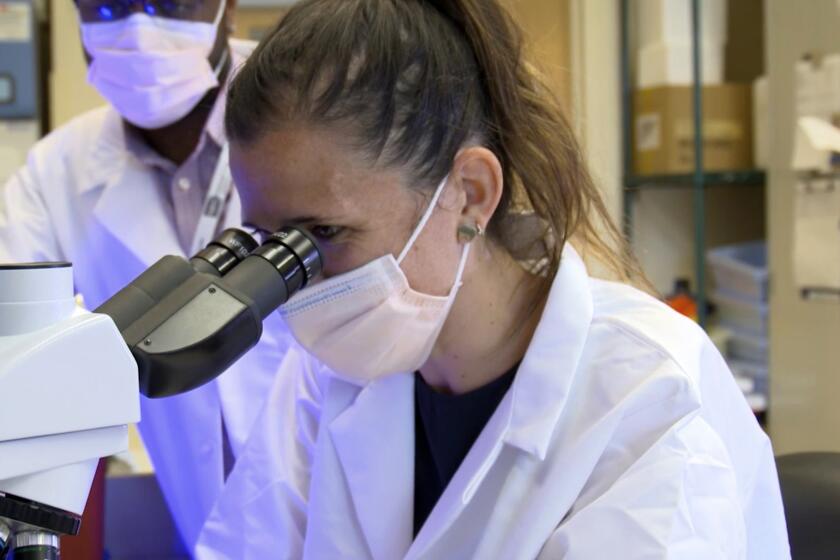Repairs Yet to Begin at Hardest-Hit Schools
- Share via
Federal grants to hard-hit city schools have reached $126 million in the year since the Northridge earthquake, but the massive aid program has failed to reach many of the campuses that were most severely damaged.
Most of the schools where repair costs exceed $500,000 have received less than half of the funding needed from the Federal Emergency Management Agency, according to a Times analysis of Los Angeles Unified School District records.
Though the aid is only slowly reaching the schools where education has been most disrupted by the disaster, overall the district has won approval for enough federal aid to pay for 84% of all earthquake repairs. The district has received about $90 million in cash, yet has spent just $34 million to date.
That uneven performance has pushed to late 1998 the completion date for all earthquake repairs, and a bitter debate has erupted over why the program has bogged down.
Federal and local education bureaucracies blame each other. District officials say the federal government is holding up the larger, more expensive projects; FEMA officials say they are approving funds in a timely manner and that the district sets the priorities.
The dispute has doubly cursed many campuses, parts of which look as if the Northridge earthquake struck yesterday.
Schools where large meeting rooms remain unrepaired have canceled assemblies and holiday programs. Students on campuses without cafeterias and lunch shelters eat under tents, or in their classrooms in inclement weather. Athletes at schools without gyms won’t host indoor competitions at home for at least another year.
For their part, principals and teachers at the most severely damaged middle and high schools say they are frustrated. They say students are being shortchanged.
“You’d think something would be done,” said Joan Elam, principal at Monroe High in North Hills, which sustained $1.4 million in earthquake damage. “It makes it so difficult when we’re looking at the same scenery a year later.”
The federal government, through FEMA, is paying for 90% of the repairs, and the state is paying the remaining 10%. The school district says it cannot afford to pay for any repairs.
Supt. Sid Thompson, who calls the process worse than ponderous, says FEMA is acting “like we’re trying to build the Taj Mahal.”
“To say it’s ponderous is the understatement of the year,” said Thompson. “It’s a long, long process.”
Overall, the district sustained earthquake damage to 5,600 buildings, with repairs estimated to cost up to $150 million. The Times analysis of records of the 19 schools that sustained more than $500,000 in damage shows:
* FEMA has not yet approved 41.5% of the funding needed to repair those 19 campuses, all of which are in the San Fernando Valley except Hamilton High School, which is on the Westside of Los Angeles. Just 8.5% of the $1.4 million needed to repair Cleveland High in Reseda, for example, was approved, and just 16.1% of the $1.8 million needed for Reseda High has been approved, according to figures supplied by the school district last month.
* Of those 19 schools, seven have received between 55% and 99.7% of the funds they need for repairs.
* Funding for complete repairs has been approved for only one school, Van Gogh Street Elementary in Granada Hills, which was the only campus in the LAUSD system to be completely destroyed. That approval--for $6 million--came last week, just four days before the anniversary of the quake. Reconstruction is now scheduled to be completed in 1996.
* Total repair costs for 554 buildings at the 19 heavily damaged campuses are estimated at $45 million. To date, about $26.3 million--or 58.5%--has been approved. Before the Van Gogh funding last week, 45.5% had been approved by FEMA.
* Damage survey reports--one of the first steps in the funding process--have yet to be completed by FEMA in 69 cases. Until they are completed, full funding cannot even be considered for 17 of the 19 schools.
* The single most expensive project, Kennedy High School in Granada Hills, is expected to cost $19.9 million--of which almost 68% has been approved. But the district has spent less than one-third of the money it has on hand: just 21.6%, or $4.3 million. District officials say that they are waiting for plan approvals before they can begin further construction at the school and that the funding for the gymnasium and the oral arts classroom building still have not been approved.
* FEMA has approved only 22% of the money needed to repair El Camino Real High School in Woodland Hills. But LAUSD has forged ahead with repairs, pouring $2.8 million into the school from federal cash advanced to the district shortly after the quake, which gave officials wide discretion over repairs.
* Actual construction began at just nine of the heavily damaged schools in 1994, and the bulk of the projects won’t get under way until at least this spring.
School district officials say they are being stymied by a lengthy federal review process. They say FEMA frequently requests detailed architectural and engineering studies on the larger projects, such as gymnasiums and auditoriums, before funding is approved.
FEMA officials acknowledge that the repair projects, often the most costly ones, require more detailed studies. “Obviously, it will take longer,” said James Lee Witt, the FEMA director. “It’s important that these buildings are built back to meet life-safety standards.”
But FEMA and other government officials are quick to point out that students are all back in classrooms and that they are proud of their recovery efforts. A glossy report released by FEMA last week, in fact, prominently features remodeled classrooms and quotes from administrators praising the work.
FEMA officials deny that they are purposefully slow to approve the projects simply because they are more expensive. “We do not drag our feet--absolutely not,” said Frank Kishton, FEMA’s federal coordinating officer for earthquake recovery.
To help streamline the process, the school district holds weekly meetings with officials from FEMA and the state Office of Emergency Services, which also reviews repair plans and funding requests.
School district officials say they push projects at those meetings. Campuses that are highlighted at those meetings are more closely examined and sometimes funding is approved more rapidly. District officials say they simply can’t inquire about all their priorities every week.
“You can’t push on every school every week,” said Roger Rasmussen, the district’s liaison with the federal and state disaster agencies. “The number of things they can work on is just limited. Obviously when you push certain projects you make a choice and you make a priority.”
FEMA officials say the school district sets the pace for project approvals by making new requests every week. “They’re prioritizing the projects,” Kishton said. “There are a lot of projects that are moving. And, obviously, we need to look at our process to keep it going.”
Principals say they are constantly giving tours of their damaged campuses to inspectors and district maintenance workers.
“A lot of activity but not much action,” said Principal Dick Cord, summing up the situation at Portola Middle School in Tarzana, which sustained more than $1.8 million in damage and has received $1 million from FEMA. “There’s this constant reminder of the earthquake because of the chain-link (fences) and the closed multipurpose room. We were very much aware that we had a bad earthquake the whole semester.”
At Holmes Middle School in Northridge, which sustained nearly $1 million in damage, the campus is lacking 19 damaged classrooms. Said Ron Twombly, the Holmes principal: “It sidetracked a lot of efforts and a lot of programs.”
At Nobel Middle School, which sustained about $585,000 in damage, the multipurpose room still is unusable. “We really, really miss it,” said Rita Davis, the principal at Nobel. “We’ve had no large assemblies. In fact, our assemblies have not been much at all.”
Reseda High’s auditorium, which today looks exactly as it did on Jan. 17, with huge light fixtures and chunks of the ceiling lying on the chairs below, had been used for community gatherings, such as musical group performances and Neighborhood Watch meetings.
“The auditorium is really a community center,” said Bob Kladifko, the principal at Reseda, which also has 10 damaged and unusable classrooms. “We try to be understanding, but it’s difficult for our parents and those of us at the school.”
Thompson, who first pledged to have repairs under way by the 1-year anniversary, is now looking to the fall of 1996 for most campuses.
“My feeling is we’ve done well but not nearly enough,” Thompson said on the eve of the earthquake anniversary. “When they build a nuclear power plant at San Onofre, they go through a lot of steps, too. But we need these schools now.”
Times staff writer Doug Smith contributed to this story.
(BEGIN TEXT OF INFOBOX / INFOGRAPHIC)
Repairing the Schools
The Los Angeles Unified School District complains that the process of getting federal funds to repair earthquake-damaged campuses is slow. The Federal Emergency Management Agency says that the funding is being approved without delays, but that the most costly projects just take longer. Here is the status of some of the bigger jobs:
Kennedy High School:
Location: Granada Hills
Estimated Damage: $19,859,023
Approved by FEMA: $13,451,343 (68%)
Already Spent: $4,291,589
Construction Began: June, 1994
Construction Ends: Sept., 1998
Administration building was demolished, will need to be rebuilt. Auditorium and classroom buildings closed. Gymnasium unusable. Two classroom buildings have been remodeled.
*
Hamilton High School:
Location: Los Angeles
Estimated Damage: $1,100,000
Approved by FEMA: $238,880 (22%)
Already Spent: $237,680
Construction Began: Feb., 1995
Construction Ends: May, 1995
Damage to gymnasium, covered walkways and classrooms.
*
Frost Middle School:
Location: Granada Hills
Estimated Damage: $1,939,597
Approved by FEMA: $284,946 (15%)
Already Spent: $253,197
Construction Began: May, 1995
Construction Ends: August, 1995
Bridges and walkway covers (arcades) damaged.
*
Portola Middle School:
Location: Tarzana
Estimated Damage: $1,851,709
Approved by FEMA: $1,021,923 (55%)
Already Spent: $304,685
Construction Began: March, 1995
Construction Ends: June, 1995
Multipurpose room closed, outdoor walkway covers damaged.
*
Reseda High School:
Location: Reseda
Estimated Damage: $1,826,094
Approved by FEMA: $294,239 (16%)
Already Spent: $274,136
Construction Began: Jan., 1995
Construction Ends: N/A
Ten classrooms and the auditorium are unusable.
*
Holmes Middle School:
Location: Northridge
Estimated Damage: $948,690
Approved by FEMA: $174,901 (18%)
Already Spent: $170,921
Construction Began: March, 1995
Construction Ends: June, 1995
Nineteen classrooms unusable; computer lab relocated. Damaged lunch arcades.
*
1. LAUSD personnel inspect school buildings: Of the LAUSD’s 11,000 buildings, damage is reported to 5,600.
2. FEMA inspection: FEMA team begins visiting the 5,600 school buildings to confirm damage.
3. FEMA prepares damage survey reports: FEMA works on 5,570 damage reports.
4. Negotiation: The district and FEMA evaluate and negotiate damage reports and costs.
5. FEMA review: FEMA reviews the damage reports and makes changes
6. FEMA authorization: FEMA authorized $126 million to be paid to the LAUSD.
7. LAUSD begins spending: Of $126 million authorized, $90 million received by district so far.
Source: Los Angeles Times computer analysis of Los Angeles Unified School District data.
More to Read
Sign up for Essential California
The most important California stories and recommendations in your inbox every morning.
You may occasionally receive promotional content from the Los Angeles Times.













